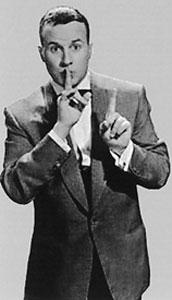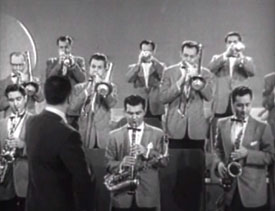 Ralph Flannagan & His Orchestra's The Stars & Stripes Forever (1952) doesn't sound that promising at first blush, a patriotic number recorded live as a Snader Telescription in the post-war period. Ralph Flannagan & His Orchestra's The Stars & Stripes Forever (1952) doesn't sound that promising at first blush, a patriotic number recorded live as a Snader Telescription in the post-war period.
They'd first recorded this in 1950, but it it was the flip-side of the single that became popular, "Giananna Mia," which they re-released a year later as an A-side with "Joshua." Getting rid of "Stars & Stripes" had been a good call.
Ralph appears at the front of this Snader telescription almost apologetically explaining they have their own version of the John Phillips Sousa march. His attitude seems to imply it might not be as worthless a performance as we suspect. If only.
It begins as the familiar high school marching band arrangement a bit speeded up for something approximating jazz effect, dominated by saxophones. The swing arrangement doesn't get it nearly far enough away from the amateur marching band sound, although a brief piano solo by Ralph is vaguely interesting.
Toward the end they boogie it up a bit. "Stars & Stripes" as boogie woogie tune comes off more as comedy than improvement of the number. In the main, Ralph should've apologized much more than he did.
He'd had two years since first srecording it to think it over, lit should've been jettisoned altogether from the band's repertoir.
His blind spot was due to the swing arrangement the Glenn Miller Orchestra having played swing versions of patriotic ditties during the war. Flanagan alas was slavishly devoted to the Miller sound, & just never figured out that for this number at least, the year the Miller orchestra played it was the consequential thing.
So Flanagan was a dime short & day late. Except nostalgia for wartime swing made Flanagan bankable, & since the John Philips Sousa story was filmed as Stars & Stripes Forever the same year as the telescription was made, it may have had some cache for a few months of that year.
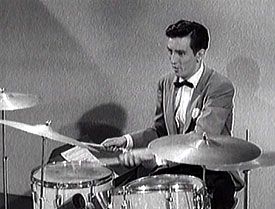 Ralph & his orchestra got on my shitlist due to Stars & Stripes Forever. I tried to keep an open mind for their moderate hit, Joshua (1952), though the generic fanfare that opens this Snader Telescription is pretty off-putting.
Ralph & his orchestra got on my shitlist due to Stars & Stripes Forever. I tried to keep an open mind for their moderate hit, Joshua (1952), though the generic fanfare that opens this Snader Telescription is pretty off-putting.
A handsome hip-looking young drummer, Jimmy "Jase" Campbell, is rather misplaced in this square group, & would make his own name with better bands.
He strikes up a good jazz beat on his kit, then section by section, the band does a very nice swing rendition of "Joshua at the Battle of Jericho." Well okay, Ralph's orchestra may not be the best of the era, but he's not inevitably entirely stinkeroo.
The drummer does a new introductory beat, the band stands up & sings a line of the song, then a sax soloist does a bang-up job while the band claps & shouts behind him. With all that background yelling, gotta give the band credit at this point for striving to entertain.
The number's actually over-arranged, with subtle drum solo between each movement, from muted trumbones, to saxes, & so on. It fades out at the end & Ralph even shushes the audience. In general I liked this one; better than the band's other telescriptions anyway.
As a 78 rpm, it had been the B-side of their re-released single "Giannina Mia" just one year earlier, & a year earlier as teh A-side with "Spring Will Be Late" on the reverse of the 78 rpm record.
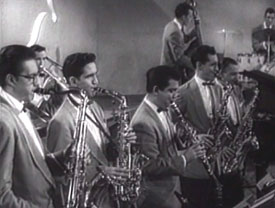 Giannina Mia (1952) opens with reeds dominant on a slow-jazz swing standard, which almost sounds like the themesong from the old Carol Burnett Show, though can't quite sing "I'm glad we had this time together" to the instrumental.
Giannina Mia (1952) opens with reeds dominant on a slow-jazz swing standard, which almost sounds like the themesong from the old Carol Burnett Show, though can't quite sing "I'm glad we had this time together" to the instrumental.
They're doing an okay job, but if I'd gone to a big dance & this was as good as the band got, would I ever be disappointed. That this was Flanagan's signature number is kind of sad.
It's rather too generic throughout with no outstanding moments as it moves from section to section with the orchestra's usual Glenn Miller Lite attitude.
Once more only Flanagan's own brief moments at the piano at all impresses. He frankly wasn't a great pianist, but his arrangements shined best for piano, & he should've leaned on that more.
He was a shy man in all aspects of his life, & he never really put himself first. It's too bad he didn't have enough ego to star himself a bit more, but he was convinced his bandmates were wonderful & deserve all the noise.
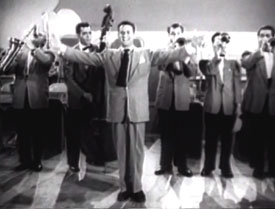 Dixie Jump (1952) with Ralph Flanagan & His Orchestra has the identical look of the rest of Ralph's Snader Telescrilptions, as they were all filmed back to back in a single day on the same stage without much visual variation.
Dixie Jump (1952) with Ralph Flanagan & His Orchestra has the identical look of the rest of Ralph's Snader Telescrilptions, as they were all filmed back to back in a single day on the same stage without much visual variation.
To large degree that's the problem with his musical arrangements, too: too little variation. The arrangements are by-the-numbers generic.
Dixie Jump gives a swing arrangement to "Wish I Were in Dixie." It was the A-side of their semi-hit single, with "Just One More Chance" on the B-side.
Ralph gives his favorite saxophonist another solo moment in front of the band, while the rest of the band claps & hollars behind the sax. This part isn't bad but doesn't last long. A trumpeter comes forward for his turn soloing, but he's not the equal of the saxophonist.
Next to come forward is a trumbonist whose solo is okay, & the tune by now has broken down some of its components & transforms so no longer a rendition of "Dixie," sounding increasingly like standard Glenn Millery swing.
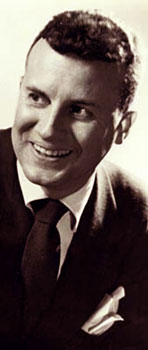 The Flanagan telescriptions in total don't come off as particularly significant. But they can be seen on dvds such as Swing Era: George Shearing (2003) worth checking out for the other material on the compilation; & The Snader Telescriptions: Big Bands Volume 2; aka, Jazz Legends: Big Bands Volume 2(2004). The Flanagan telescriptions in total don't come off as particularly significant. But they can be seen on dvds such as Swing Era: George Shearing (2003) worth checking out for the other material on the compilation; & The Snader Telescriptions: Big Bands Volume 2; aka, Jazz Legends: Big Bands Volume 2(2004).
His telescriptions are also encountered alongside better material divided between Meet the Band Leaders volumes one (1984) & two (1985), & encountered one or another in similar compilations, i.e., "Dixie Jump" in Jumpin' & Jivin' Volume I (2007) with loads of better stuff (Calloway, Waller, Shaw, Jordan, & so on).
Ralph had been an arranger for better bands during the '30s until the early '40s before going into the Merchant Marines, working behind the scenes for Sammy Kaye, Charlie Barnett, Tony Pastor & Alvino Ray, among others.
He was back from the war in 1947 but didn't form his own band until 1949, when the big band era was just about to wind down. Even the most successful bands were beginning to strip down to combos & quintets to keep finances in check. It wasn't a propitious time for new big bands, but Flanagan against all odds managed to become popular by avoiding originality.
Though dead, Glenn Miller was still popular & practically a brand name. Stateside Glenn's band was operated by Tex Beneke from 1946 to 1950, a right granted by Miller's widow since Beneke had in the late '30s helped the great bandleader in perfecting the style that for many swing fans remains even today the keystone of the era's music.
But due to restrictions that required no advancement in musical style, he broke from the band, & established his own orchestra, relentlessly advertised as "Tex Beneke & His Orchestra Playing the Music that Made Glenn Miller Famous."
Ralph Flanagan's manager Herb Hendler knew the Miller band as it then stood without Glenn Miller, & the Beneke orchestra combined, could never be booked into all the venues, mainly dance halls, that wanted that sound.
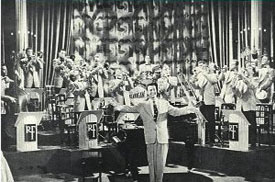 So Hendler pretty much instructed Flanagan to be an imitation of Glenn Miller, Ralph having already issued "Glenn Miller tributes" to some success. So Hendler pretty much instructed Flanagan to be an imitation of Glenn Miller, Ralph having already issued "Glenn Miller tributes" to some success.
Ralph was in fact an all-round imitator, having formerly used his chameleonic abilities to arrange for other bands in their styles. But of all the bands he imitated, it was Miller he did best, & ultimately he copied him exclusively.
Flanagan didn't balk at being manipulated. He was not personally savvy about the music business, & realized this was as big a shot as he'd ever get. The success of this gambit was annoying to Beneke who felt the decline of the Miller band & the limitations his own imitation-band faced were was partially the fault of Flanagan keeping the nostalgia alive.
Beneke believed the Miller sound should progress & grow as it always had before, but no one wanted to hear anything new. If it came down to a choice of Flanagan's allegedly "authentic" imitation, Beneke's "advances" on the sound, or even the the Glenn Miller Orchestra of the 1950s under a succession of justly forgotten hack bandleaders, Flanagan won hands-down.
Flanagan's manager went so far as to book group "on the trail" of Miller & Beneke orchestras, until Beneke felt hounded. Hendler even got Chesterfield cigarettes -- Miller's old advertiser for a radio show -- to sponsor Flanagan's radio program, & Flanagan roled over like passive dog to have his band called the Chesterfield Orchestra.
Although this really bothered Tex Beneke, fact is, he couldn't blame his troubles on one dogged imitator, he could screw up well enough on his own time.
As a Miller impersonator always on the road, Ralph Flanagan was seen by millions, was reliable for that certain sound "untained" by the new bebop, & so was undeservedly popular. They had some bigger hits but most of those ("Hot Toddy," "Flanagan's Boogie," "Singing Winds") are excluded from the telescriptions, except for their signature song "Giananni Mia" which as one of their best condemns them more than anything.
copyright © by Paghat the Ratgirl
|
